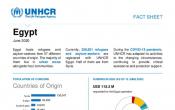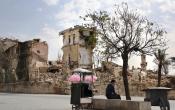Egypt
Operation: Egypt
Location
{"longitude":30,"latitude":27,"zoom_level":0,"iso_codes":"'EGY'"}
By clicking on the icons on the map, additional information is displayed.
The boundaries and names shown and the designations used on this map do not imply official endorsement or acceptance by the United Nations.
Key Figures
| 2019 year-end results | |
| 119,300 | vulnerable refugees and asylum-seekers were provided with winter assistance, in addition to 2,900 UASC |
| 66,100 | individuals were supported with monthly multipurpose cash grants to meet basic needs, in addition to 3,300 UASC who received financial assistance |
| 59,300 | primary health care consultations were provided, as well as 13,000 referrals to secondary and tertiary health services |
| 48,400 | children benefitted from UNHCR education grants |
| 9,900 | first instance refugee status determination (RSD) interviews were conducted |
| 2020 planning figures | |
| 52,400 | asylum-seekers will be registered on an individual basis |
| 38,300 | refugee and asylum-seeker households will receive multi-purpose cash grants |
| 23,700 | refugee and asylum-seeker households with primary and secondary school aged children will be provided with education grants (47,000 students) |
| 20,000 | substantive status determination decisions will be taken |
| 4,900 | refugees and asylum-seekers will be referred to secondary and tertiary medical care |
Latest Updates
People of Concern
3%
Increase in
2019
2019
| 2019 | 324,740 |
| 2018 | 314,937 |
| 2017 | 289,231 |

[["Refugees",258401],["Asylum-seekers",66335],["Stateless",4]]
Loading ...
Egypt
< Back
2019
{"categories":[2015,2016,2017,2018,2019,2020],"budget":[85.170372352,82.27679034,79.08958703,74.46865337,104.15671601999999,118.31243389],"expenditure":[46.44128458000001,45.61564518,42.6004643,42.82142057,46.118503350000005,null]}
{"categories":[2015,2016,2017,2018,2019,2020],"p1":[85.120372352,82.27679034,79.08958703,74.46865337,104.15671601999999,118.31243389],"p2":[0.05,null,null,null,null,null],"p3":[null,null,null,null,null,null],"p4":[null,null,null,null,null,null]}
{"categories":[2015,2016,2017,2018,2019,2020],"p1":[46.40966352,45.61564518,42.6004643,42.82142057,46.118503350000005,null],"p2":[0.03162106,null,null,null,null,null],"p3":[null,null,null,null,null,null],"p4":[null,null,null,null,null,null]}
Loading ...
CHOOSE A YEAR
- 2014
- 2015
- 2016
- 2017
- 2018
- 2019
- 2020
Operational context
Egypt was both a destination and a transit country for mixed movements in 2019 - however, access to the country remained tightly controlled, resulting in many who sought international protection entering the country irregularly.The Government of Egypt maintained a tolerant asylum policy and continued to grant refugees and asylum-seekers access to public health care, and included South Sudanese, Sudanese, Syrians and Yemenis in the public education system.
Access to people of concern in detention remained challenging. Increased application fees and lengthy processing periods for residence permits and civil status documentation presented further difficulties for refugees and asylum-seekers.
The Government showed a growing interest in improving its asylum system, announcing the drafting of a national asylum law. UNHCR supported this effort through trainings on advanced refugee and international law.
Difficult socio-economic conditions and increased cost of living impacted the lives of refugees and asylum-seekers and their host communities. This was compounded by limited formal livelihood opportunities due to obstacles in obtaining work permits. Refugee and asylum-seeker children of nationalities not granted access to public education by the government of Egypt continued to rely on informal education or private schools, which were unaffordable to many.
Population trends
As of 31 December 2019, there were some 325,000 refugees and asylum-seekers; among them were more than 4,800 unaccompanied and separated children (UASC). Syrians represented 51% of the registered population, with the rest predominately originating from Eritrea, Ethiopia, Iraq, Somalia, Sudan, South Sudan and Yemen.During the year, 31,300 people were newly registered by UNHCR, including some 2,000 UASC, while 4,000 refugees departed to ten countries for resettlement.
Achievements
- RSD was utilized strategically and through differentiated processing modalities, in line with global standards and regional policies. This resulted in improved efficiency in case processing and reduced waiting periods.
- UNHCR continued to identify and register UASC, implementing best interest procedures, case management and assistance. Alternative care arrangements through partners were strengthened, as were coordination mechanisms and engagement with national authorities.
Unmet needs
The Egypt operation was only 46% funded in 2019.- Funding constraints limited UNHCR’s ability to fully meet the needs of the most vulnerable people. In 2019, cash assistance provided by UNHCR met less than half of overall needs. Additionally, a mere 21% of the population in need received monthly cash assistance.
- In the health sector, resources available to cover lifesaving and emergency interventions were limited compared to the needs, resulting in more cases added to waiting lists.
- Further resources were needed to expand sexual and gender-based violence prevention activities and to strengthen the quality and scope of services for survivors, particularly in the absence of national mechanisms.
Operational Environment
Egypt is a signatory to the 1951 Refugee Convention and its 1967 Protocol, and the 1969 OAU Convention Governing the Specific Aspects of Refugee Problems in Africa. UNHCR carries out registration, documentation and refugee status determination (RSD) under its 1954 Memorandum of Understanding with the Government of Egypt.The estimated number of people of concern to UNHCR in 2019 stands at 280,000, consisting of refugees and asylum-seekers predominantly from Iraq, Eritrea, Ethiopia, South Sudan, Sudan, Syria and Yemen. Refugees and asylum-seekers live in urban areas alongside local communities.
The protection environment remains conducive. The office is engaged in a dialogue with the Government of Egypt on the management of asylum. The Government provides access to primary and secondary health care to refugees and asylum-seekers of all nationalities at an equal level to Egyptian nationals.
Furthermore, Syrian, Sudanese and Yemeni refugees and asylum-seekers are granted access to public education on the same footing as nationals. However, the significant rise in the cost of living, following Egypt’s economic reforms, has negatively impacted refugees and asylum-seekers, increasing their vulnerability and dependence on assistance.
The Government has been able to prevent any irregular mixed movements from the northern coast of Egypt through the Mediterranean.
UNHCR works closely with the Government and its UN and NGO partners to provide protection and assistance to asylum-seekers and refugees. The refugee response is coordinated through the Inter-Agency Working Group (IAWG) led by UNHCR.
Key priorities
UNHCR’s key priorities for 2019 include preservation of the protection space, enhanced access to asylum, and prevention of refoulement. Focus will be maintained on issues related to registration, access to and release from detention, alternatives to detention, issuance of longer duration residence permits, decentralization of administrative procedures, and regularization of stay. Child protection, youth programmes, prevention of sexual and gender-based violence (SGBV) and protection from sexual exploitation and abuse will continue to be crucial. The Office will remain engaged in the response to mixed movements, and prevention of and response to human trafficking. UNHCR’s engagement with the League of Arab States is expected to continue in 2019, to build on progress made over the past years on protection issues.The overall strategy will be realized in close collaboration with national and international stakeholders, both when leading and coordinating the response, by using the Comprehensive Refugee Response Framework model. In 2019, the Office will continue to ensure the implementation of the 3RP for the Syria crisis and the Egypt Appeal for Asylum Seekers and Refugees from Sub-Saharan Africa, Iraq and Yemen, in close coordination with UN and NGO partners.
















